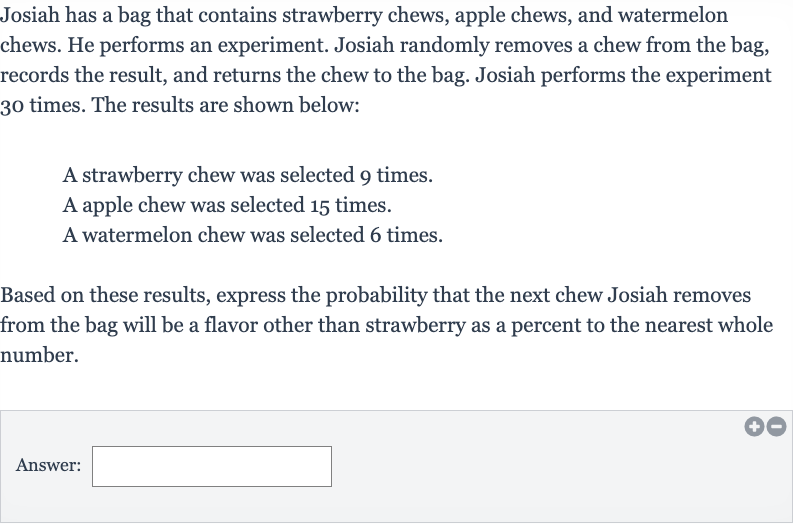AI tutor
Welcome to Bytelearn!
Let’s check out your problem:

Josiah has a bag that contains strawberry chews, apple chews, and watermelon chews. He performs an experiment. Josiah randomly removes a chew from the bag, records the result, and returns the chew to the bag. Josiah performs the experiment times. The results are shown below:A strawberry chew was selected times.A apple chew was selected times.A watermelon chew was selected times.Based on these results, express the probability that the next chew Josiah removes from the bag will be a flavor other than strawberry as a percent to the nearest whole number.Answer:
Full solution
Q. Josiah has a bag that contains strawberry chews, apple chews, and watermelon chews. He performs an experiment. Josiah randomly removes a chew from the bag, records the result, and returns the chew to the bag. Josiah performs the experiment times. The results are shown below:A strawberry chew was selected times.A apple chew was selected times.A watermelon chew was selected times.Based on these results, express the probability that the next chew Josiah removes from the bag will be a flavor other than strawberry as a percent to the nearest whole number.Answer:
- Calculate Total Non-Strawberry Selections: Determine the total number of times a flavor other than strawberry was selected. Josiah selected an apple chew times and a watermelon chew times. To find the total number of times a flavor other than strawberry was selected, we add these two numbers together. (apple chews) + (watermelon chews) = (non-strawberry chews)
- Total Experiments Conducted: Calculate the total number of experiments conducted.Josiah conducted the experiment times in total.
- Calculate Probability of Non-Strawberry Selection: Determine the probability of selecting a flavor other than strawberry. To find this probability, we divide the number of times a non-strawberry flavor was selected by the total number of experiments. Probability (non-strawberry) = Probability (non-strawberry) =
- Convert Probability to Percentage: Convert the probability to a percentage.To convert a probability to a percentage, we multiply it by .Percentage (non-strawberry) = (Probability (non-strawberry)) Percentage (non-strawberry) =
- Round Percentage to Nearest Whole Number: Round the result to the nearest whole number.Now we calculate the percentage and round it to the nearest whole number.Percentage (non-strawberry)
More problems from Find probabilities using the binomial distribution
QuestionGet tutor help
QuestionGet tutor help
QuestionGet tutor help
QuestionGet tutor help
QuestionGet tutor help
QuestionGet tutor help
QuestionGet tutor help
QuestionGet tutor help
QuestionGet tutor help
QuestionGet tutor help
